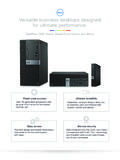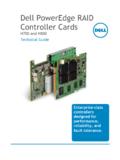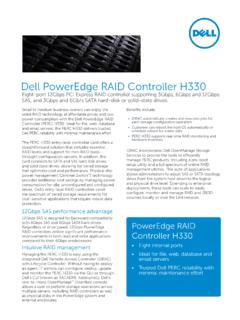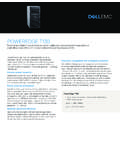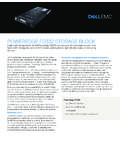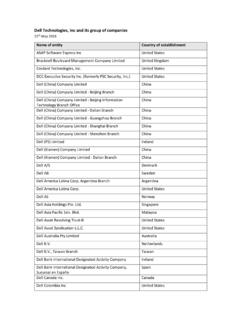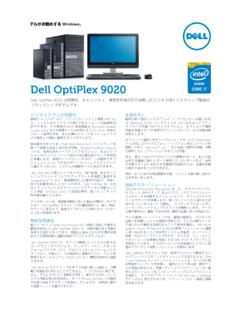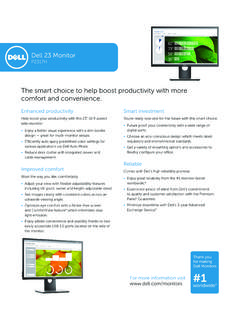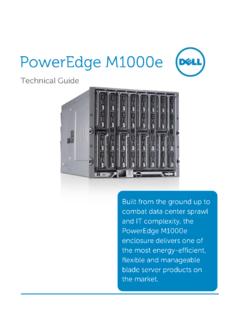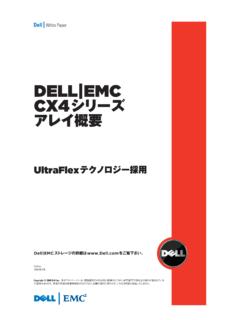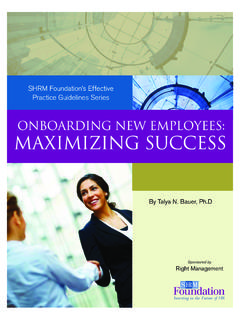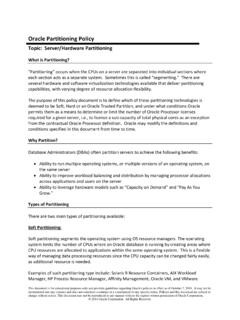Transcription of PowerEdge R730 and R730xd - Dell
1 PowerEdge R730 and R730xd Technical Guide Exceptionally flexible and scalable 2-socket, 2U rack servers delivering high-performance processing and a broad range of workload-optimized local storage options ii PowerEdge R730 and R730xd Technical Guide This document is for informational purposes only. Dell reserves the right to make changes without further notice to any products herein. The content provided is as is and without express or implied warranties of any kind. Dell, the DELL logo, PowerEdge , Compellent, EqualLogic, PowerVault, PowerConnect, OpenManage, KACE, and ReadyRails are trademarks of Dell, Inc.
2 Intel and Xeon are registered trademarks of Intel Corporation in the and other countries. Microsoft, Windows, Windows Server, BitLocker, Internet Explorer, and Hyper-V are either registered trademarks or trademarks of Microsoft Corporation in the United States and/or other countries. Novell and SUSE are registered trademarks of Novell, Inc. in the United States and other countries. IBM, Tivoli, and Netcool are registered trademarks of IBM in the United States. AMD and combinations thereof, are trademarks of Advanced Micro Devices, Inc. Other trademarks and trade names may be used in this document to refer to either the entities claiming the marks and names or their products.
3 Dell disclaims proprietary interest in the marks and names of others. Copyright 2015 Dell Inc. All rights reserved. Reproduction or translation of any part of this work beyond that permitted by copyright laws without the written permission of Dell Inc. is unlawful and strictly forbidden. June 2015 | Version iii PowerEdge R730 and R730xd Technical GuideTable of contents 1 System overview .. 6 Introduction .. 6 New technologies .. 7 2 System features .. 9 Comparison of PowerEdge systems .. 9 Specifications .. 10 3 Chassis views and features .. 13 Chassis views .. 13 Chassis features .. 16 4 Processors .. 20 Processor features.
4 20 Supported processors .. 21 GPU support .. 22 Chipset .. 23 5 Memory .. 24 Supported memory .. 24 DIMM speed .. 25 Memory configurations .. 25 Memory population guidelines .. 25 Memory RAS 26 6 Storage .. 28 Internal storage .. 28 External storage .. 31 PowerEdge RAID Controllers .. 31 Internal persistent storage .. 32 Optical drives .. 34 Tape drives .. 34 7 Networking and PCIe .. 35 Select Network Adapters .. 35 PCIe expansion .. 37 8 Power, thermal and acoustics .. 40 Power consumption and energy efficiency .. 40 Power supply units ..41 Thermal and 42 9 Rack rail systems .. 46 Sliding and static rail systems .. 46 Cable management 47 10 Operating systems and virtualization.
5 48 Supported operating systems .. 48 Supported virtualization .. 48 11 Dell OpenManage systems management .. 49 OpenManage systems management portfolio .. 49 Dell server management operations .. 55 Appendix A. Additional specifications .. 57 Chassis dimensions .. 57 Chassis 57 Power supply specifications .. 58 Environmental specifications .. 58 Video specifications .. 58 Rack rail specifications .. 59 iv PowerEdge R730 and R730xd Technical GuideUSB peripherals .. 59 Appendix B. Standards compliance .. 60 Appendix C. Additional resources .. 61 Appendix D. Support and Deployment Services .. 63 Server Deployment Services .. 63 ProSupport Enterprise Suite.
6 64 Additional professional services .. 66 Tables Table 1. New technologies .. 7 Table 2. Comparison of PowerEdge R720/R720xd and R730/ R730xd .. 9 Table 3. Technical specifications .. 10 Table 4. Chassis features .. 16 Table 5. Security features .. 19 Table 6. Supported processors .. 21 Table 7. Supported GPUs .. 23 Table 8. Memory technologies supported .. 24 Table 9. DIMMs supported .. 25 Table 10. Memory configuration and performance .. 25 Table 11. Memory populations and operating frequencies .. 26 Table 12. Memory RAS features .. 26 Table 13. Internal storage options .. 28 Table 14. Supported 29 Table 15. External storage options.
7 31 Table 16. Supported RAID 32 Table 17. IDSDM new features .. 33 Table 18. Supported Select Network Adapter options and features .. 36 Table 19. PCIe expansion slots .. 37 Table 20. PCIe slot mapping .. 37 Table 21. Optional add-in PCIe expansion cards .. 38 Table 22. Power tools and technologies .. 40 Table 23. Power supply units and Table 24. Acoustical reference points and output comparisons .. 43 Table 25. Supported rack rail system .. 47 Table 26. Operating system support .. 48 Table 27. Virtualization support .. 48 Table 28. iDRAC8 with Lifecycle Controller functions and benefits .. 50 Table 29. Feature comparison for iDRAC8 Express and Enterprise.
8 51 Table 30. One-to-one and one-to-many operations .. 56 Table 31. Chassis weight .. 57 Table 32. Power supply specifications .. 58 Table 33. Supported video modes .. 58 Table 34. Rail adjustability ranges .. 59 Table 35. Industry standard documents .. 60 Table 36. Additional resources .. 61 Figures Figure 1. R730 front view ( chassis with bezel) .. 13 Figure 2. R730 front view ( chassis without bezel) .. 13 Figure 3. R730xd front view (8 x plus 18 x with bezel) ..14 Figure 4. R730xd front view (8 x plus 18 x without bezel) ..14 Figure 5. R730 back view ..14 Figure 6. R730xd back view .. 15 v PowerEdge R730 and R730xd Technical GuideFigure 7.
9 R730 internal chassis view .. 15 Figure 8. R730xd internal chassis view .. 16 Figure 9. R730 LCD control panel .. 17 Figure 10. R730xd LED panel ..18 Figure 11. QRL on chassis ..18 Figure 12. QRL on information tag ..18 Figure 13. Accessing a QRL .. 19 Figure 14. Rack network daughter card (NDC) .. 35 Figure 15. Sliding rails with optional CMA .. 46 Figure 16. Static rails .. 46 Figure 17. Server lifecycle management operations .. 49 Figure 18. Systems management server lifecycle .. 56 Figure 19. Chassis dimensions .. 57 Figure 20. Server Deployment capabilities .. 63 Figure 21. ProSupport Enterprise Suite comparison .. 66 6 PowerEdge R730 and R730xd Technical Guide1 System overview Introduction The Dell PowerEdge R730 is a general-purpose platform with highly expandable memory (up to 768GB) and impressive I/O capabilities to match.
10 The R730 can readily handle very demanding workloads, such as data warehouses, e-commerce, virtual desktop infrastructure (VDI), databases and high-performance computing (HPC). In addition to the R730 s capabilities, the R730xd offers extraordinary storage capacity, making it well suited for data-intensive applications that require storage and I/O performance, like medical imaging and email servers. Deliver peak performance Drive peak compute performance across a variety of workloads with the Intel Xeon processor E5-2600 v3 product family and state-of-the-art DDR4 memory. Boost data access for applications with up to 16 x 12Gb/s SAS drives and high-performance dual RAID.
